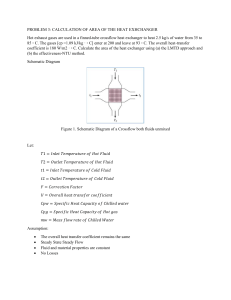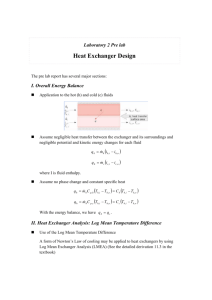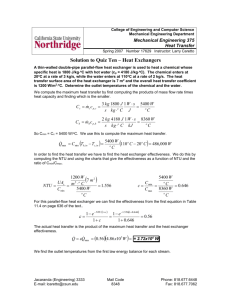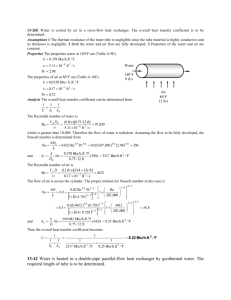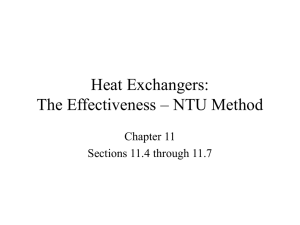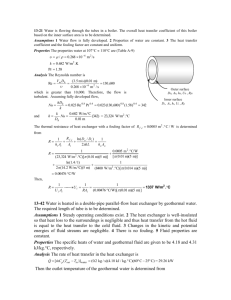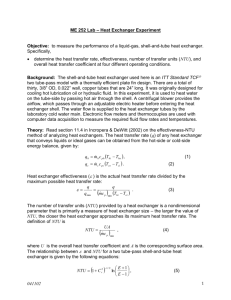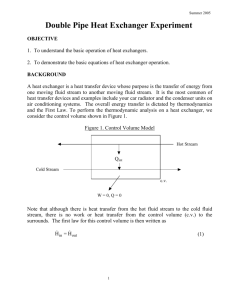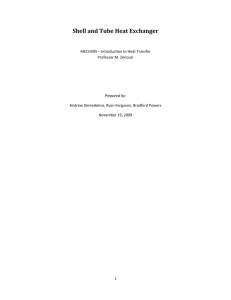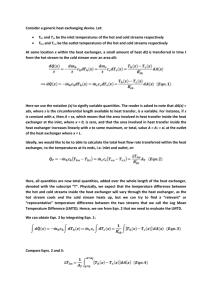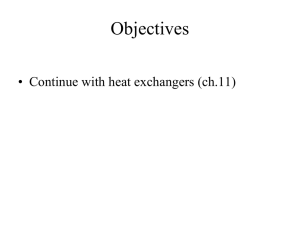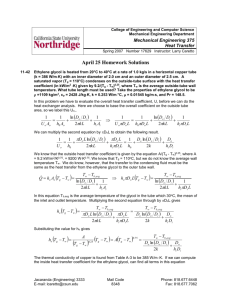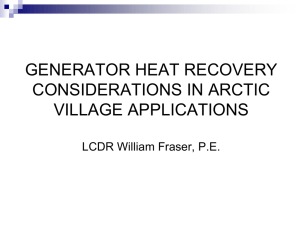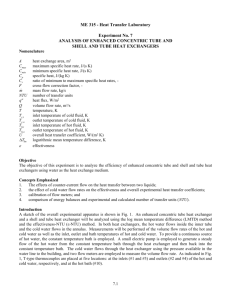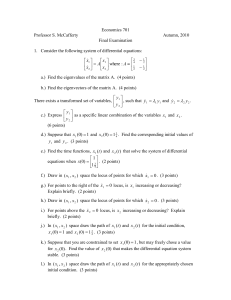Heat Exchangers
advertisement
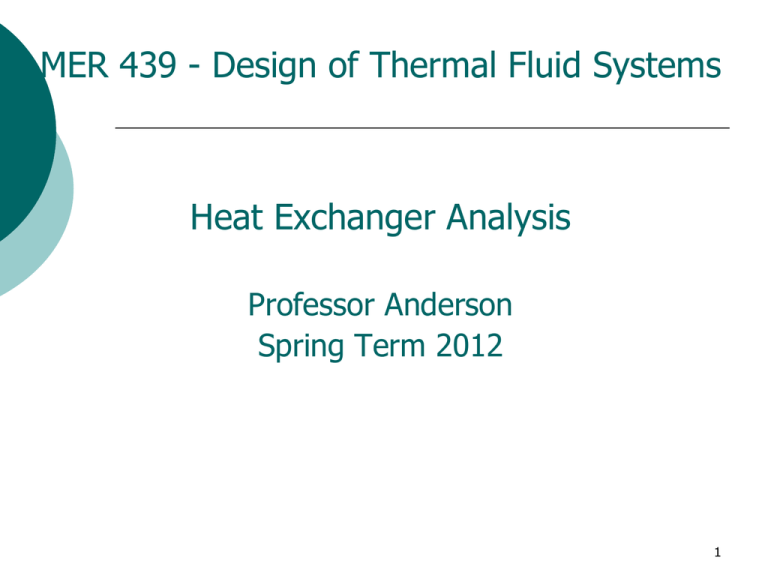
MER 439 - Design of Thermal Fluid Systems Heat Exchanger Analysis Professor Anderson Spring Term 2012 1 Outline (1) Heat Exchanger Types (2) Heat Exchanger Analysis Methods Overall Heat Transfer Coefficient fouling, enhanced surfaces LMTD Method Effectiveness-NTU Method 2 HX Classifications 3 HX Classifications 4 Heat Exchanger Types Concentric tube (double piped) 5 Heat Exchanger Types Concentric tube (double piped) One pipe is placed concentrically within the diameter of a larger pipe Parallel flow versus counter flow Fluid B Fluid A 6 Heat Exchanger Types Shell and Tube 7 Heat Exchanger Types Compact Heat Exchangers 8 Heat Exchanger Types Cross Flow finned versus unfinned mixed versus unmixed 9 Heat Exchanger Types 10 Heat Exchanger Types 11 Heat Exchanger Analysis Overall Heat Transfer Coefficient LMTD Effectiveness-NTU 12 Overall Heat Transfer Coefficient The overall coefficient is used to analyze heat exchangers. It contains the effect of hot and cold side convection, conduction as well as fouling and fins. Rf ,c Rf ,h 1 1 1 Rw UA (o hA)c (o A)c (o A) h (o hA) h Rf foulingfactor 13 Enhanced Surfaces 14 Log-Mean Temperature Difference To relate the total heat transfer rate to inlet and outlet fluid temperatures. Apply energy balance: 15 Log-Mean Temperature Difference We can also relate the total heat transfer rate to the temperature difference between the hot and cold fluids. let T Th Tc Q UATLM . 16 The log mean temperature difference depends on the heat exchanger configuration Th,in Th,in Th,out Tc,out Tc,in Th,out Tc,out Tc,in 17 LMTD Parallel-Flow HX Q UATLM TLM T2 T1 ln(T2 / T1) Wherefor P arallelFlow : T1 Th,1 Tc,1 Th,i Tc,i T2 Th, 2 Tc,2 Th,o Tc,o 18 LMTD Counter-Flow HX Q UATLM T2 T1 TLM ln(T2 / T1) Wherefor CounterFlow : T1 Th,1 Tc,1 Th, i Tc, o T2 Th,2 Tc,2 Th, o Tc, i Tlm,CF > Tlm,PF FOR SAME U: ACF < APF 19 LMTD- Multi-Pass and Cross-Flow Apply a correction factor to obtain LMTD Q UATLM TLM FTLM ,CF t: Tube Side 20 LMTD Method Sizing a Heat Exchanger: Calculate Q and the unknown outlet temperature. Calculate DTlm and obtain the correction factor (F) if necessary Calculate the overall heat transfer coefficient. Determine A. The LMTD method is not as easy to use for performance analysis…. 21 The Effectiveness-NTU Method Define Qmax for Cc < Ch for Ch < Cc or Qmax = Cc(Th,i - Tc,i) Qmax = Ch(Th,i - Tc,i) Qmax = Cmin(Th,i - Tc,i) e q qmax Ch (Th,i Th,o ) Cmin (Th,i Tc,i ) Cc (Tc,o Tc,i ) Cmin (Th,i Tc,i ) Q = eCmin(Th,i - Tc,i) 22 The Effectiveness-NTU Method For any heat exchanger: e f(NTU,Cmin/Cmax) NTU (number of transfer units) designates the nondimensional heat transfer size of the heat exchanger: UA NTU Cmin 23 The Effectiveness-NTU Method 24 The Effectiveness-NTU Method PERFORMANCE ANALYSIS Calculate the capacity ratio Cr = Cmin/Cmax and NTU = UA/Cmin from input data Determine the effectiveness from the appropriate charts or e-NTU equations for the given heat exchanger and specified flow arrangement. When e is known, calculate the total heat transfer rate Calculate the outlet temperature. 25 The Effectiveness-NTU Method SIZING ANALYSIS When the outlet and inlet temperatures are known, calculate e. Calculate the capacity ratio Cr = Cmin/Cmax Calculate the overall heat transfer coefficient, U When e and C and the flow arrangement are known, determine NTU from the e-NTU equations. When NTU is known, calculate the total heat transfer surface area. 26 The Homework 27
